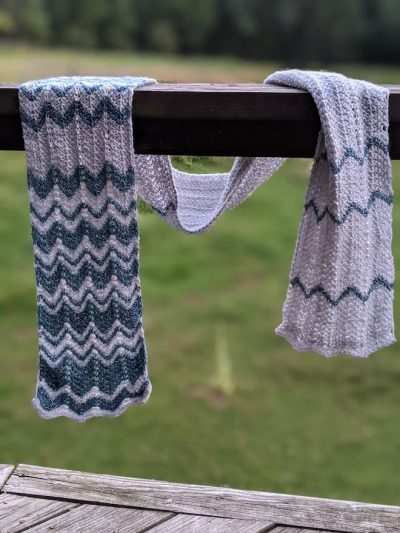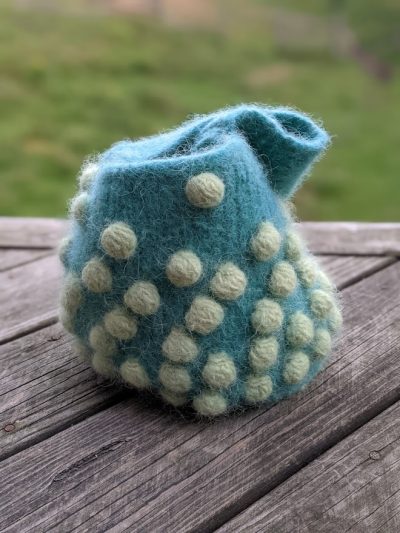By Michale Glennon, Adirondack Watershed Institute
Do you like science? Art? Water? Wool? You can join a unique project showcasing scientific data and local fiber arts with the Paul Smith’s College Adirondack Watershed Institute.
Wool and Water is a data art project in which we are using knitting, crochet, weaving and other fiber arts to illustrate concepts and trends related to our waterways. This effort blends fiber art with scientific data to create visual representations of changing water quality conditions in the Adirondacks and Lake Champlain Basin.
The project is a celebration of the 50th anniversary of the Clean Water Act and is supported by the Champlain Valley National Heritage Partnership. As the project continues to grow, we are hoping to connect with fiber farmers and artists in the Adirondacks, to demonstrate the interconnection between water and agriculture.
How Do You Represent Science With Knitting?

The Champlain Ice Scarf
This is a representation of lake ice history on Lake Champlain, which has one of the longest records of documented ice-in and ice-out dates. In recent years, the lake has frozen less frequently as a result of a warming climate. This scarf depicts every year since 1816; each year is one row and blue years are those years in which the lake did not freeze completely. The white rows indicate years when the lake did freeze, and there are beads (hard to see) in one of three columns to indicate a freeze date in January (left column), February (middle), or March (right column). Freeze dates have shifted slightly later over time, and years without a complete freeze have increased in frequency.

The HAB Bag
This felted bag depicts the occurrences of Harmful Algal Blooms (HABs) reported to the New York State Department of Environmental Conservation in Adirondack lakes between 2012 and 2020. HABs result from the rapid growth of algae or cyanobacteria that can cause harm to people, animals, and our ecosystems. HABs occur naturally but factors such as increased nutrient loading and pollution, alteration of food webs, introduced species, modifications of water flow, and climate change may all contribute to their increasing frequency and intensity.
How Can I Get Involved?
This project is collaborative and we would love to have you!
If you are a knitter, crocheter, weaver, or another fiber artist and you would like to create something for the project, you can find inspiration, patterns, and a contact form at the bottom of our Wool and Water webpage.
We are also looking to work with Adirondack fiber producers to showcase their products and highlight the cultural heritage of the region. If you raise fiber animals, please email me.
Visit the Display
The existing and continually growing collection is currently on display at the Paul Smith’s College Visitor Interpretive Center. It has visited other locations and we hope to continue to showcase it throughout the Basin and to host events to bring people together over fiber, art, science, and craftivism. We will have some large celebrations next August during Adirondack Water Week, but in the meantime are happy to host workshops or zoom meetings with anyone interested.
Take a look at our recent blog post to read more about the project and join us in celebrating clean water with fiber arts!
Wool & Water was funded by an agreement P21AC11821-00 awarded by the United States National Park Service (NPS) to NEIWPCC in partnership with the Champlain Valley National Heritage Partnership.
Learn more about the data and process behind “Wool and Water” in the webinar below:
